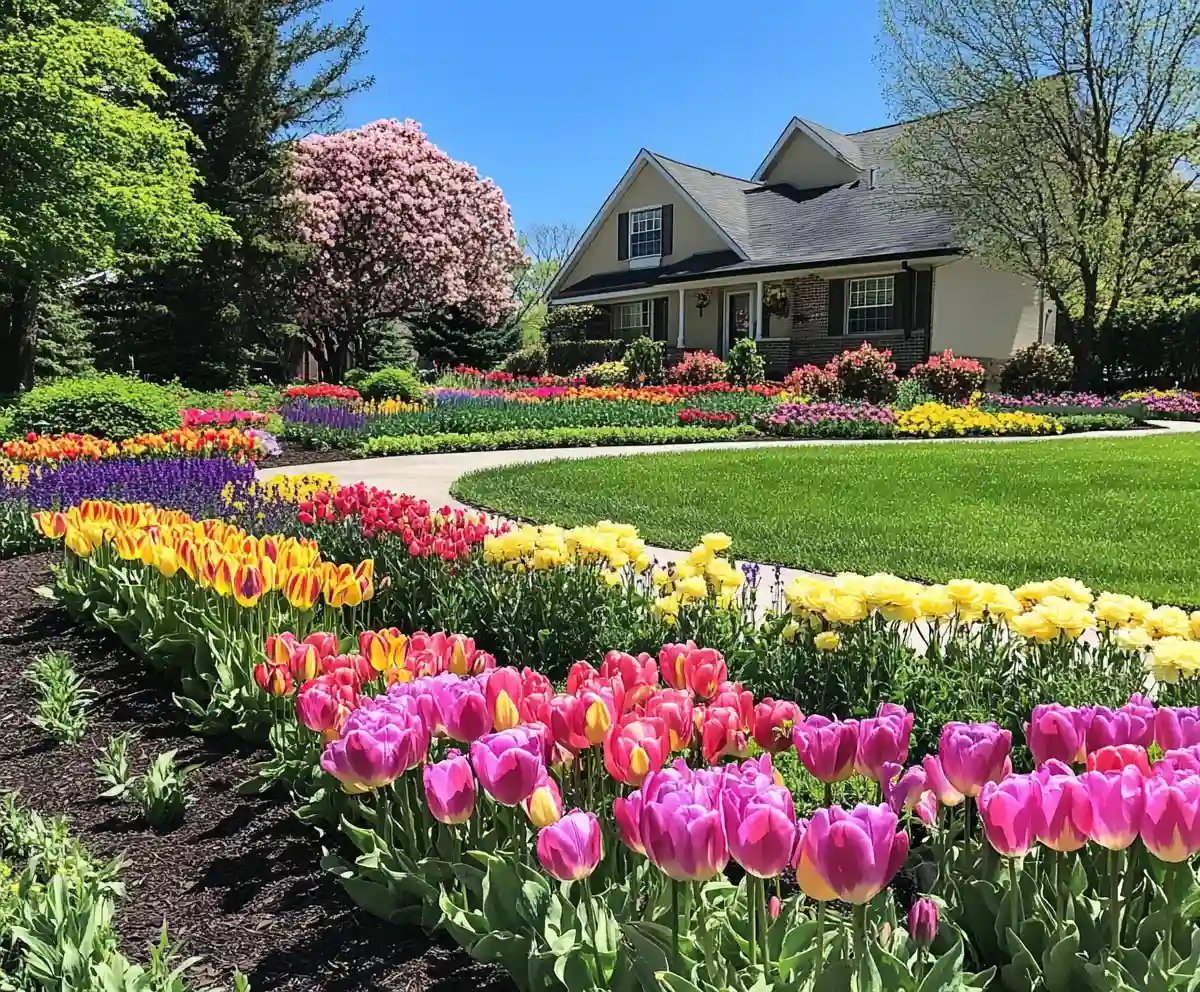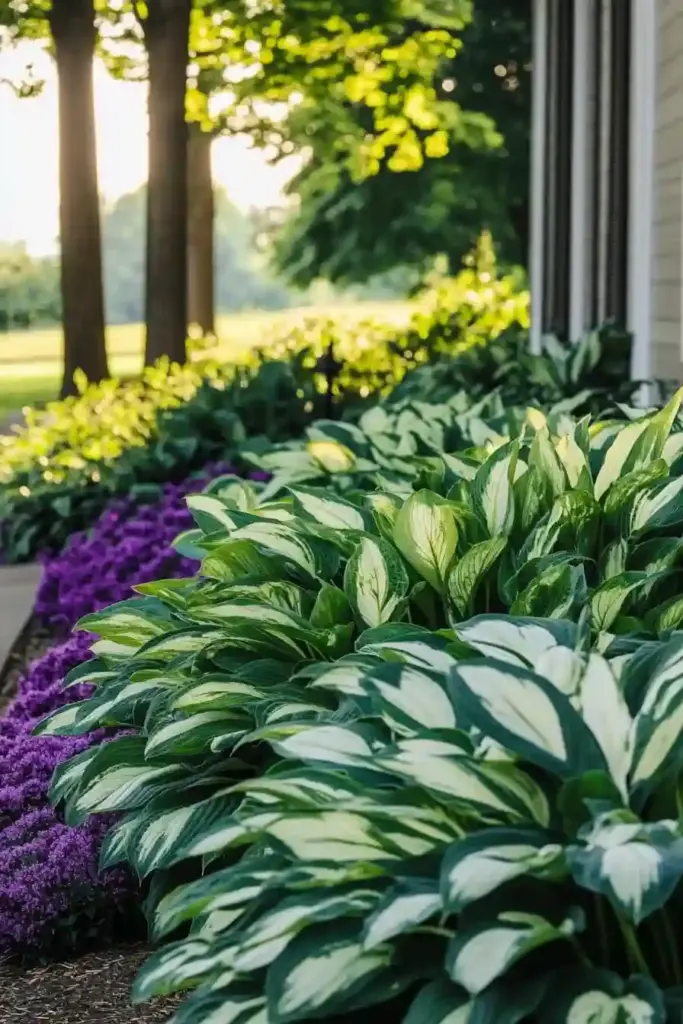Want to make your home stand out from the street? One of the easiest and most charming ways to enhance your front yard is by creating stunning flower beds. Whether you’re working with a small patch of lawn or a sprawling garden space, the right floral design can instantly elevate your home’s curb appeal and give it a warm, welcoming feel.
In this guide, you’ll discover 21 beautiful flower beds in front of house ideas that are not only eye-catching but also practical and easy to maintain. From low-maintenance perennials to bold color combinations and creative planting layouts, we’ll walk you through everything you need to brighten your home’s entrance—one bloom at a time.
🌿 1. Hostas: Low-Maintenance Shade Lovers for a Lush Look
If your front yard has shady spots, hostas are a go-to choice that never disappoints. These hardy perennials come in a stunning variety of leaf shapes, sizes, and colors—from deep green to creamy white variegation—adding both texture and depth to your garden beds.
Why Choose Hostas?
- Thrive in partial to full shade
- Ideal for planting under trees or along walkways
- Pair beautifully with ferns, hydrangeas, and other shade-loving plants
Expert Tip: Group different hosta varieties together for a layered look. Taller ones go in the back, with smaller, compact types up front. Add a touch of mulch and regular watering, and your hosta bed will stay fresh and vibrant all season long.
“Mixing textures and shades of green adds a designer touch—without needing a green thumb!”
🌞 2. Daylilies: Colorful, Carefree Blooms for All Seasons
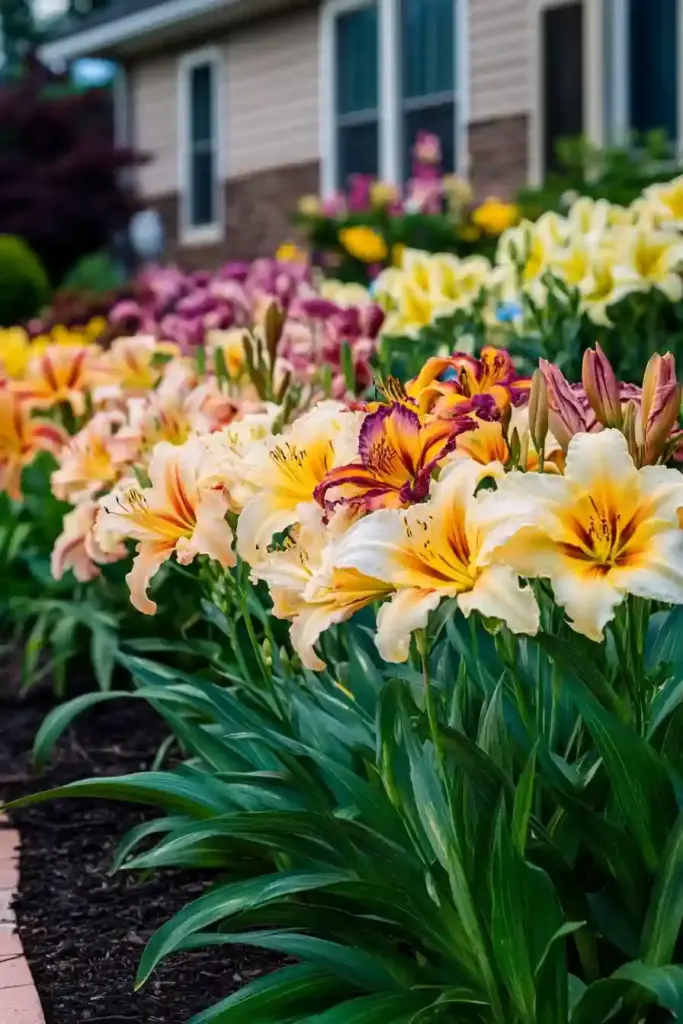
Daylilies are the workhorses of any front yard flower bed. Bursting with vibrant colors from early spring through late summer, these tough perennials are loved for their ability to thrive in a variety of soil conditions—and look good doing it.
Why Choose Daylilies?
- Come in a rainbow of colors: yellows, oranges, pinks, purples, and more
- Low maintenance and drought-tolerant once established
- Perfect for borders, mixed flower beds, or mass plantings
Planting Tips:
- Choose a sunny location for optimal blooming
- Space plants 18–24 inches apart to prevent crowding
- Water regularly, especially during hot spells
Pro Tip: For an effortless garden aesthetic, pair daylilies with ornamental grasses or contrasting foliage. They’ll create a beautiful backdrop without stealing the show.
“Daylilies are a front-yard favorite because they look stunning—even when you forget to water them!”
🌺 3. Peonies: Timeless Elegance with Lush, Fragrant Blooms
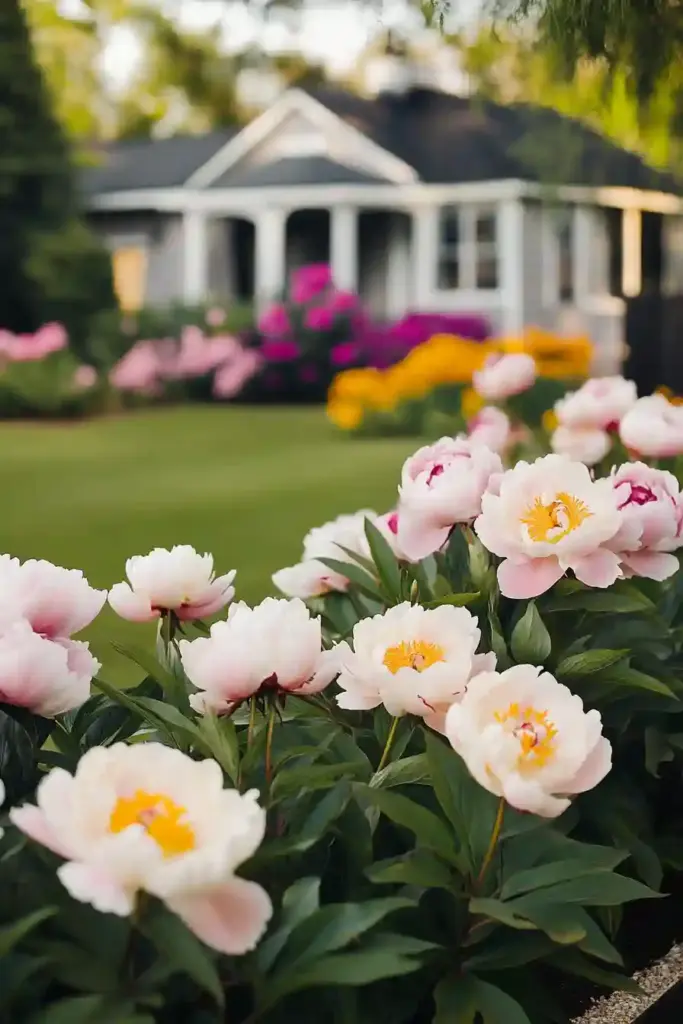
Few flowers make a statement like peonies. With their full, ruffled blooms and intoxicating fragrance, these perennials add a luxurious, romantic touch to any front yard garden. Whether you’re aiming for classic curb appeal or cottage-garden charm, peonies always deliver.
Why Choose Peonies?
- Available in dreamy shades of pink, white, and red
- Long-lived perennials—many thrive for decades with minimal care
- Bloom in late spring to early summer, just when your yard needs a pop
Growing Tips:
- Plant in a sunny spot with well-drained soil
- Give each peony about 3 feet of space to spread and breathe
- Stake taller varieties to keep heavy blooms upright
Design Idea: Surround peonies with shorter fillers like alyssum or creeping phlox to create a soft edge. You can also mix them with other spring bloomers like tulips for a layered seasonal display.
“Peonies planted in groups make your entryway look like a floral magazine cover—year after year!”
💧 4. Hydrangeas: Big Blooms That Steal the Show
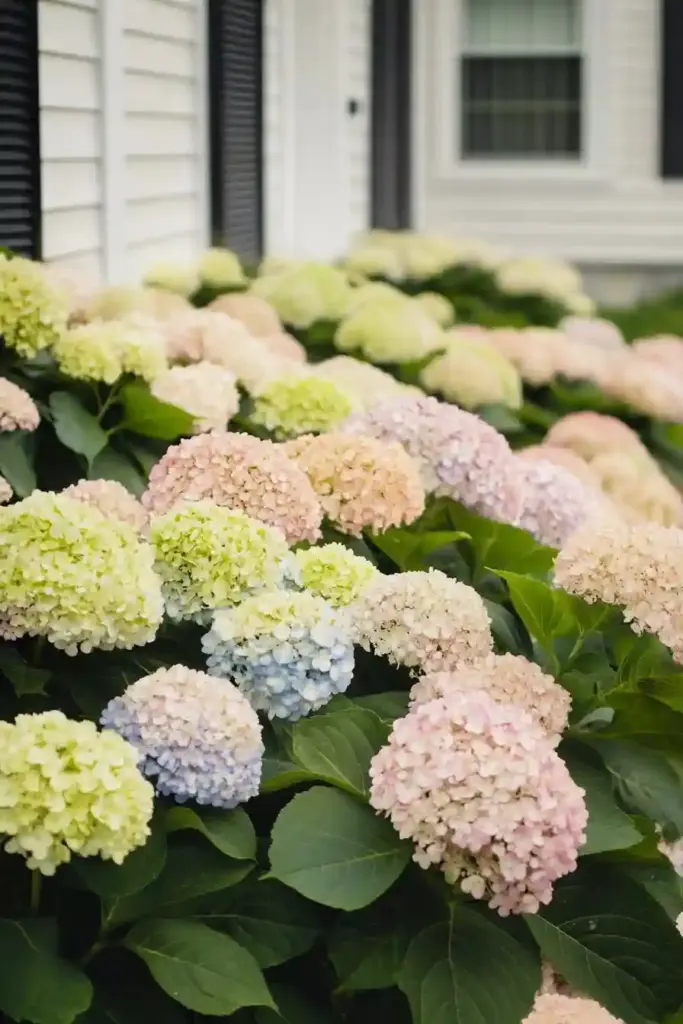
If you’re dreaming of bold, full flower heads that turn heads, hydrangeas are your front yard’s best friend. These versatile shrubs offer large, globe-like blossoms in stunning hues—ranging from blue and pink to white and even green, depending on the soil’s pH.
Why Choose Hydrangeas?
- Bloom from late spring to fall for extended color
- Great for both sunny and partly shaded areas
- Fast-growing and excellent for filling large spaces
Hydrangea Care Tips:
- Plant where they’ll receive morning sun and afternoon shade
- Space them 3 to 4 feet apart to allow airflow
- Water deeply once or twice per week—especially when newly planted
Styling Tip: Combine hydrangeas with evergreen shrubs or ornamental grasses to create contrast and structure. Their dramatic blooms also work well as a hedge or backdrop for shorter perennials.
“Hydrangeas aren’t just pretty—they’re bold, easy to care for, and give your front yard a designer edge.”
🌾 5. Lavender: Fragrance, Color, and Pollinator Power
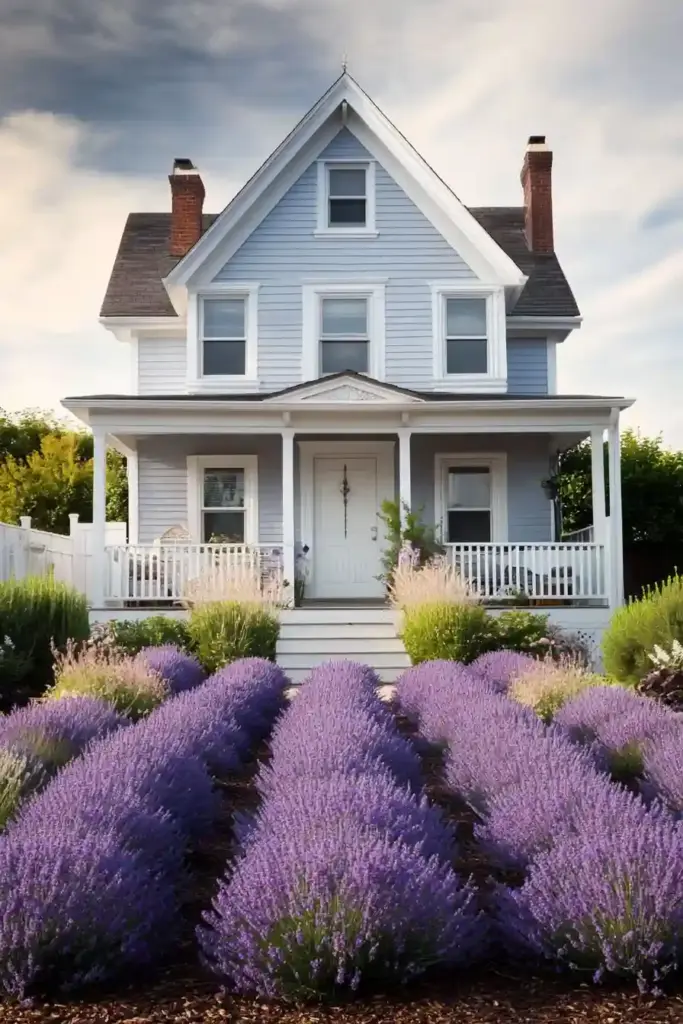
Want a flower that looks beautiful, smells amazing, and helps your whole garden thrive? Lavender checks all the boxes. With its soft purple spikes and soothing scent, lavender adds elegance to your flower beds while attracting bees and butterflies—boosting pollination for everything else.
Why Choose Lavender?
- Drought-tolerant and low-maintenance
- Adds height and texture to garden borders
- Naturally repels pests like mosquitoes and deer
Planting Pointers:
- Loves full sun and well-drained soil—avoid soggy spots
- Plant in groups or rows for a bold, aromatic effect
- Prune in early spring to keep it compact and encourage fresh blooms
Design Inspiration: Use lavender along walkways or garden edges where guests can brush against it and enjoy the scent. It also pairs beautifully with roses, echinacea, and ornamental grasses.
“Lavender adds charm and calm—plus, it smells like a spa every time you step outside.”
🌹 6. Roses: Timeless Beauty for an Elegant Entryway
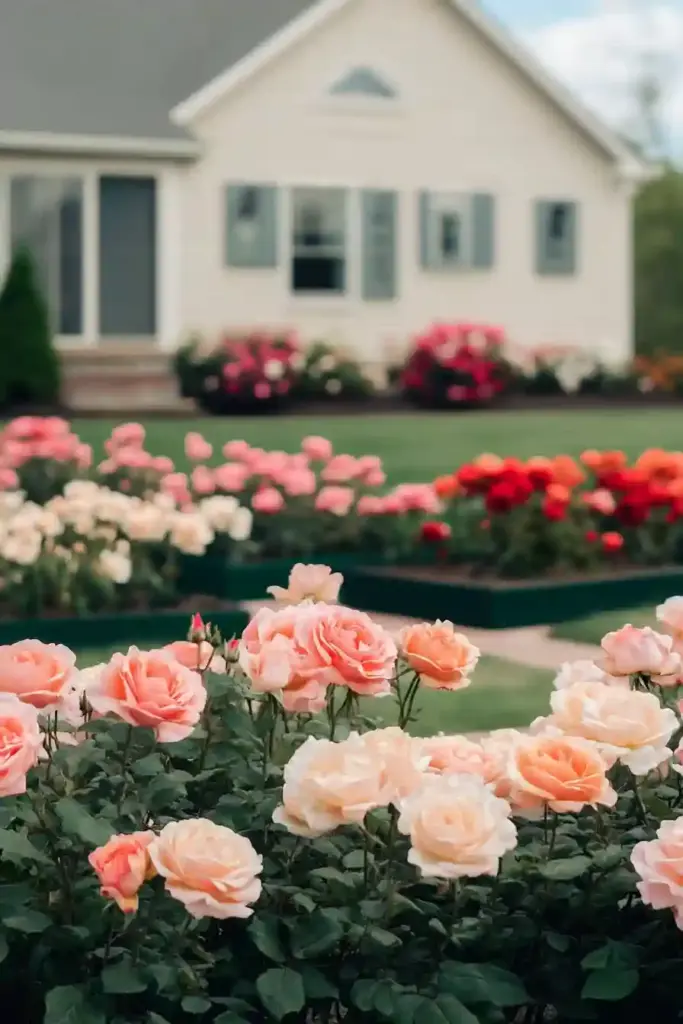
No front yard flower bed is complete without the queen of the garden—roses. Whether you prefer traditional hybrid teas, easy-care shrub roses, or cascading climbers, roses bring structure, fragrance, and elegance to your landscape like nothing else can.
Why Choose Roses?
- Come in endless colors, sizes, and bloom shapes
- Bloom repeatedly from spring through fall with proper care
- Offer stunning fragrance and visual appeal
Growing Guidelines:
- Choose a sunny location with at least 6 hours of daily light
- Ensure soil drains well to prevent root rot
- Water deeply once a week and mulch around the base to retain moisture
Design Tip: Try planting low-growing companion flowers—like lavender, alyssum, or creeping thyme—around your rose bushes to fill in the space and enhance the aesthetic. For a dramatic effect, flank your front porch or walkway with rose bushes or use climbing varieties on trellises.
“Plant roses early in the season so they establish strong roots before summer heat kicks in—your future self will thank you!”
🌷 7. Tulips: Spring’s Boldest and Brightest Blooms
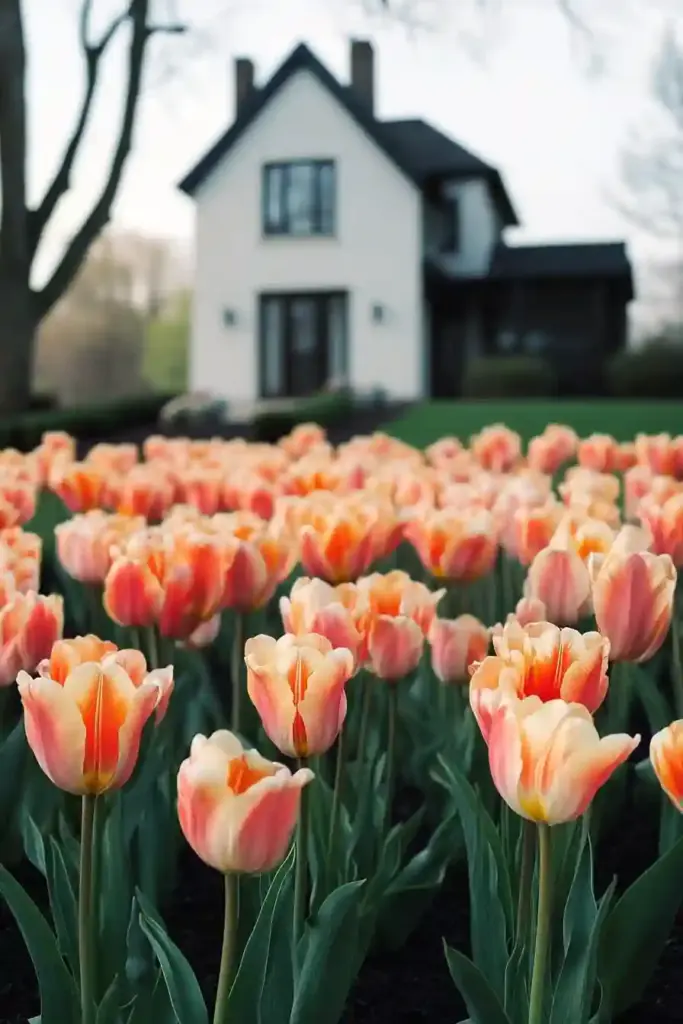
Few flowers say “welcome home” like a bed of cheerful tulips. These springtime stars are loved for their brilliant colors and neat, cup-shaped blooms that create an instant focal point in any front yard. Plant them in clusters, and you’ve got yourself a picture-perfect entrance come spring.
Why Choose Tulips?
- Available in nearly every color, from bold reds to pastel pinks
- Bloom early, often right after winter fades
- Easy to mix and match for creative color schemes
Tulip Tips:
- Plant bulbs in the fall, 6 to 8 inches deep in well-drained soil
- Choose a sunny spot for best results
- Water well after planting, then let nature take its course
Design Idea: Group tulips in odd numbers (like 5, 7, or 9) for a natural look. Combine with daffodils or grape hyacinths for a layered spring bed that fades beautifully into summer perennials.
“For maximum impact, go bold—plant tulips in big sweeps or color blocks near your entry path.”
🌼 8. Daffodils: Bright, Cheerful Blooms That Signal Spring
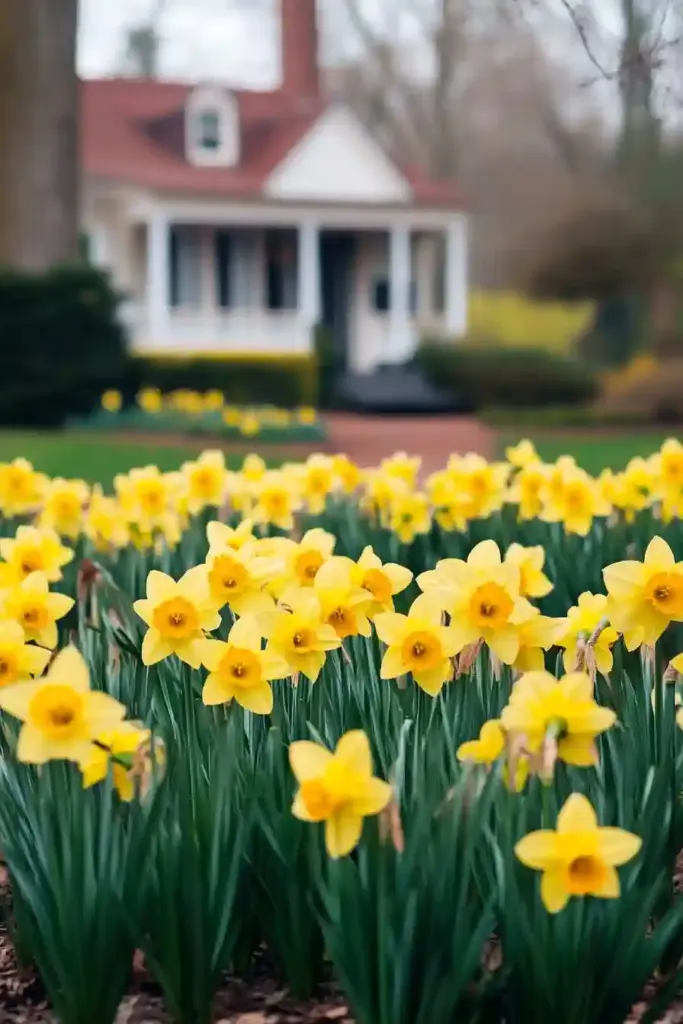
Looking to brighten up your landscape after a long winter? Daffodils are just what your front yard needs. These golden-hued blooms are among the first to emerge in early spring, creating a joyful and uplifting display right by your home’s entrance.
Why Choose Daffodils?
- Hardy and reliable—return year after year
- Deer- and rodent-resistant
- Thrive in a wide range of climates
Planting Notes:
- Plant bulbs in the fall, 6 inches deep, with the pointy end up
- Choose full sun or partial shade
- Water after planting, then enjoy low-maintenance beauty come spring
Design Tip: For a naturalized look, scatter daffodil bulbs randomly instead of planting in straight rows. You can also plant them in clusters under trees or near mailboxes for pops of sunshine where you least expect them.
“Daffodils don’t just brighten your yard—they lift your mood and welcome the season with joy.”
🌸 9. Lilies: Elegant Showstoppers with Summer Appeal
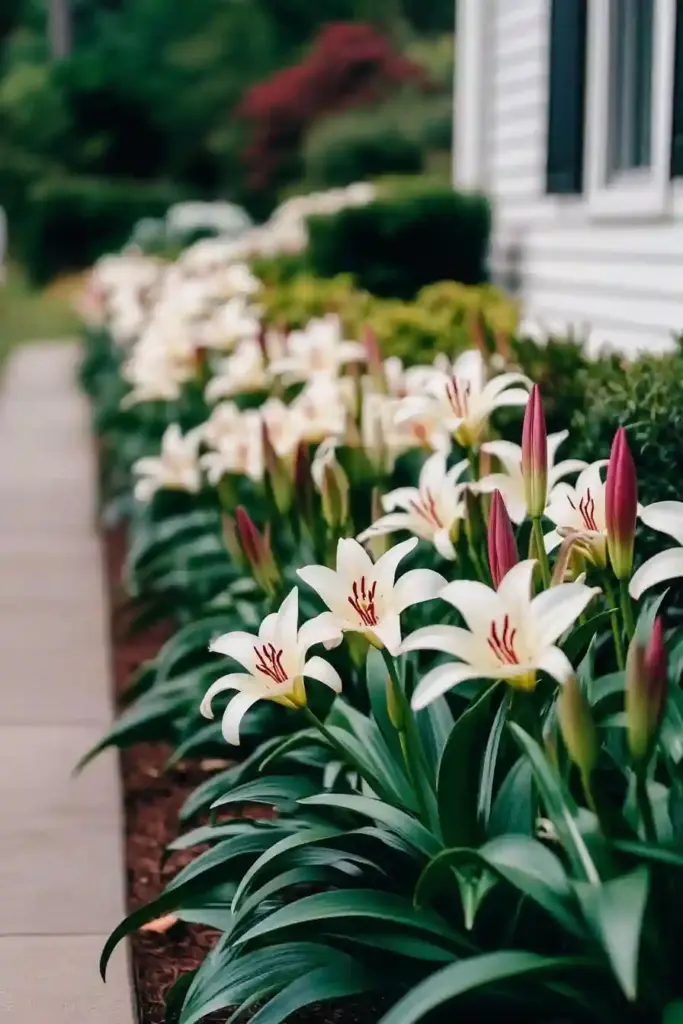
If you want to add height, fragrance, and sophistication to your front flower beds, lilies are a must-have. Their trumpet-shaped blooms stand tall and proud, making them perfect for layered garden designs or as bold vertical accents along entry paths.
Why Choose Lilies?
- Come in a wide variety of colors and bloom shapes
- Excellent for adding vertical interest to beds
- Attract pollinators like butterflies and hummingbirds
Growing Tips:
- Plant in a sunny spot with well-drained soil
- Space bulbs about 8 inches apart and 6 inches deep
- Stake taller varieties to keep them from toppling in the wind
Design Idea: Combine lilies with medium-height plants like coneflowers or daisies for a tiered effect. For extra color and coverage, plant short annuals like marigolds at the base.
“Plant your lilies in groups for bold, eye-catching clusters—and don’t forget to mix colors for a dramatic flair.”
🧡 10. Marigolds: Vibrant, Pest-Resistant Garden Heroes
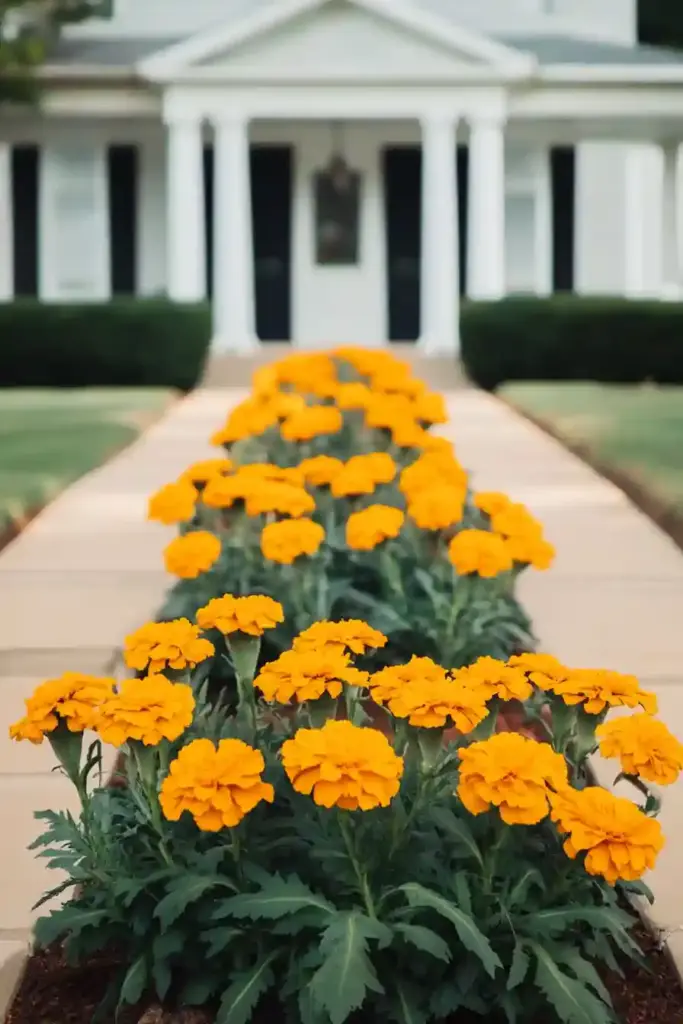
Marigolds are the sunshine of the flower bed—bursting with bright yellow, orange, and red hues that instantly lift the energy of your front yard. Not only are they eye-catching, but these hardy annuals also help keep pests away, making them a practical and pretty choice for any garden.
Why Choose Marigolds?
- Long-lasting blooms from spring through fall
- Natural insect repellent—great companion plant
- Easy to grow and tolerate a range of soil conditions
How to Grow:
- Choose a sunny spot; marigolds love full light
- Plant in rows or clusters for maximum impact
- Water regularly, especially during hot or dry weather
Design Tip: Use marigolds to edge your flower beds or line your walkway for a vibrant, uniform look. You can also mix them with petunias or zinnias for a colorful, low-maintenance combo.
“These little dynamos add more than just color—they protect your plants and bloom like champs all season long.”
🌺 11. Begonias: Shade-Loving Beauties with Bold Color
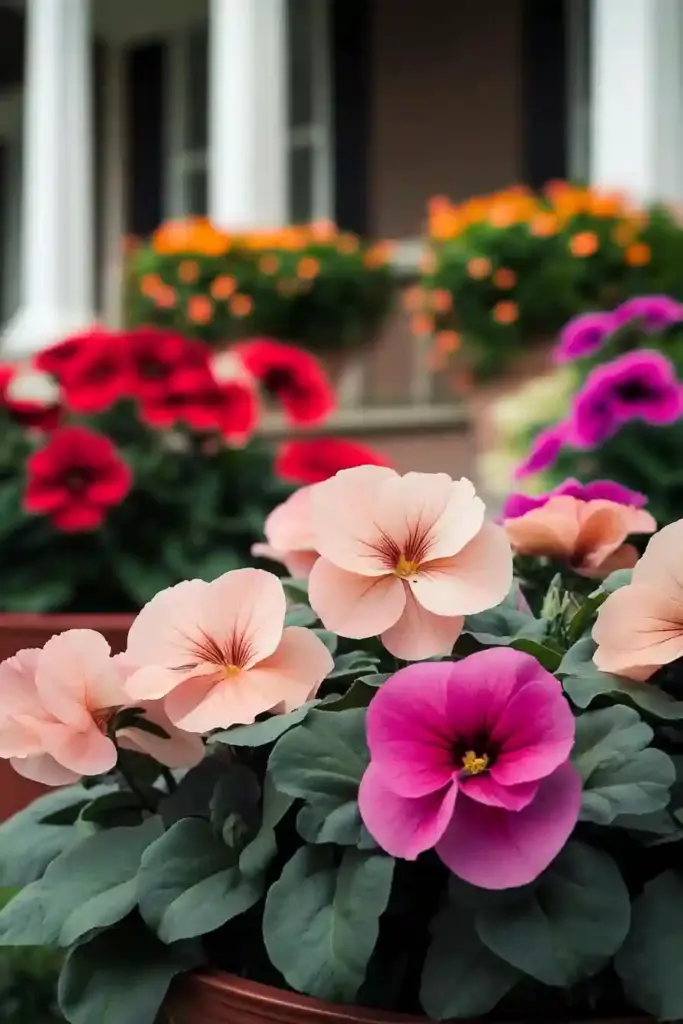
If your front yard gets more shade than sun, begonias are a colorful solution that won’t disappoint. With their vibrant blooms and uniquely textured leaves, begonias bring personality and charm to any garden bed, porch container, or hanging basket.
Why Choose Begonias?
- Thrive in partial to full shade
- Come in many colors: red, pink, white, orange, and more
- Work well in beds, containers, or hanging baskets
Planting & Care Tips:
- Use well-draining soil and avoid waterlogged spots
- Keep soil consistently moist—but not soggy
- Mulch helps retain moisture and suppress weeds
Design Tip: Pair begonias with ferns or impatiens for a soft, layered shade garden. Try mixing fibrous and tuberous begonias to vary texture and color height.
“Begonias are your secret weapon for brightening up shady corners—plus, they’re easy to care for and bloom nonstop!”
🌸 12. Petunias: Bright, Bountiful, and Perfect for Borders
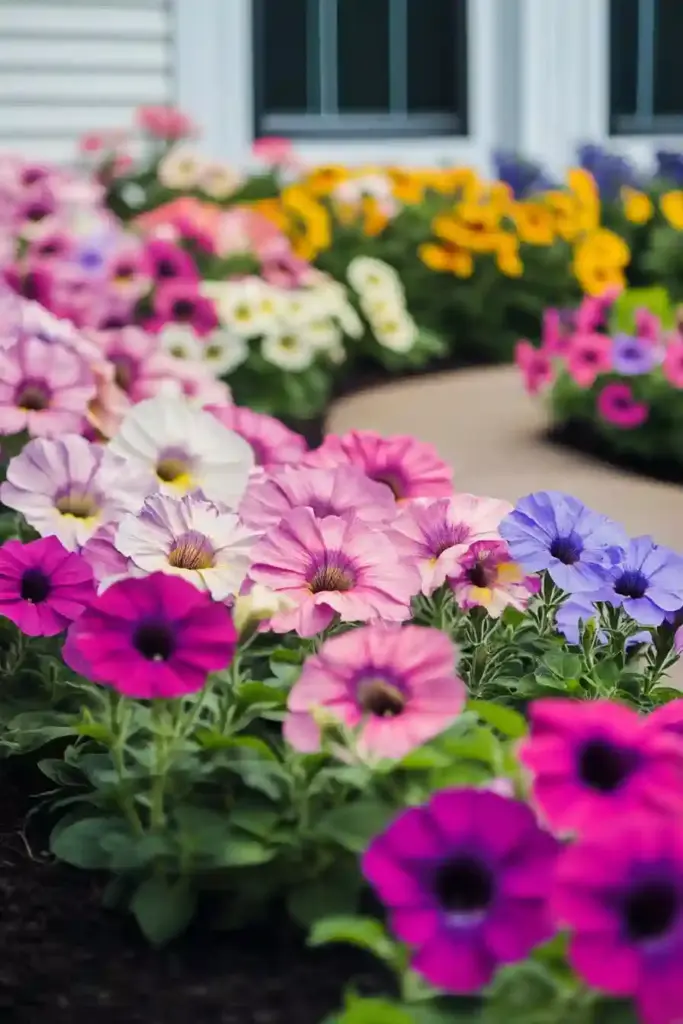
Petunias are like confetti for your front yard—cheerful, colorful, and totally irresistible. These popular annuals bloom nonstop from spring through fall and are perfect for filling gaps in flower beds, adding pops of color to containers, or cascading from hanging baskets.
Why Choose Petunias?
- Available in nearly every color and pattern
- Long blooming season with minimal upkeep
- Great for borders, planters, and vertical displays
Petunia Pointers:
- Choose a sunny location for best blooming
- Water regularly, especially in heat, and allow soil to drain well
- Deadhead faded flowers to encourage continuous blooms
Design Idea: Plant petunias along the edge of your front bed or in tall urns by your door. Mix wave or trailing varieties with upright types for dynamic texture and flow.
“For a show-stopping entrance, layer petunias in hanging baskets or tall containers—hello, curb appeal!”
🌼 13. Zinnias: Bold Summer Color with Minimal Effort
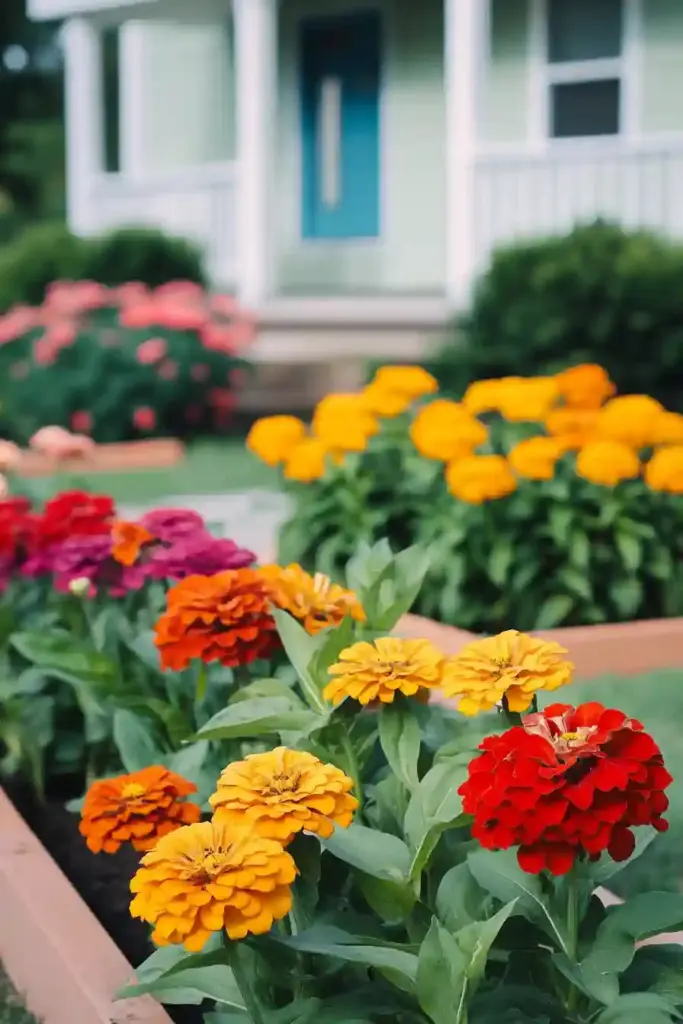
If you want vibrant flowers that practically take care of themselves, zinnias are your go-to. These sun-loving annuals offer a kaleidoscope of colors and bloom like crazy all summer long. Perfect for pollinators, they’ll bring butterflies flocking to your front yard.
Why Choose Zinnias?
- Come in vivid shades of red, pink, yellow, orange, and more
- Excellent heat and drought tolerance
- Easy to grow from seed or starter plants
How to Grow:
- Pick a full-sun spot with good air circulation
- Space plants to prevent mildew (about 12–18 inches apart)
- Water at the base to keep foliage dry and healthy
Design Tip: For a cottage garden look, plant zinnias in sweeping clusters or blend them with coneflowers, salvia, or marigolds. They also shine in porch planters or window boxes.
“Zinnias bring the wow-factor with almost zero fuss—they’re the summer MVPs of any front garden.”
🌺 14. Geraniums: Classic Color That Pops All Season
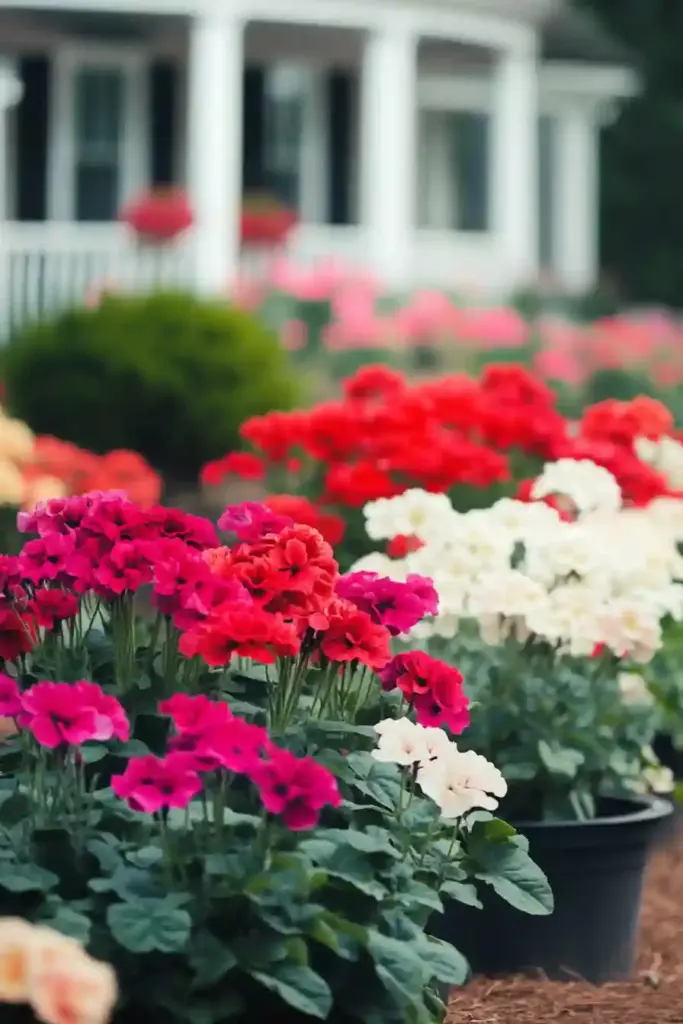
Geraniums are a front yard favorite for a reason—they’re bold, reliable, and effortlessly stylish. With clusters of blooms in red, pink, white, and purple, these hardy flowers brighten up beds, borders, and containers alike, thriving in sunny spots with minimal fuss.
Why Choose Geraniums?
- Long blooming season from spring through frost
- Easy to grow and tolerant of heat and drought
- Perfect for beds, window boxes, or pots on your porch
Care Tips:
- Plant in full sun for vibrant, abundant blooms
- Allow soil to dry slightly between waterings
- Deadhead spent flowers to encourage continuous flowering
Design Tip: Mix geraniums with trailing plants like sweet potato vine or ivy in porch planters for a full, cascading look. For front beds, combine them with silver dusty miller or white alyssum for a high-contrast combo that really pops.
“Geraniums are like the little black dress of the garden—timeless, versatile, and always in style.”
💜 15. Phlox: Soft, Spreading Blooms That Attract Butterflies
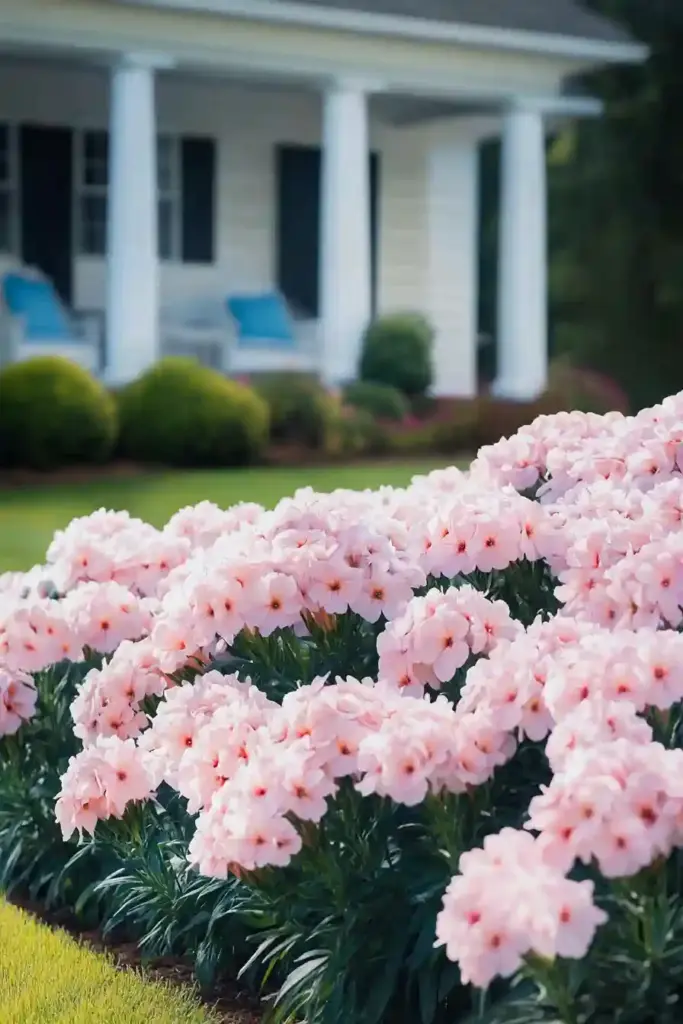
Phlox brings a soft, romantic charm to front yard flower beds. With clusters of small, fragrant blooms in shades of pink, purple, white, and even blue, phlox is a favorite for filling in spaces and attracting pollinators like butterflies and hummingbirds.
Why Choose Phlox?
- Available in tall or low-growing varieties
- Perfect for borders, cottage gardens, or ground cover
- Blooms throughout the summer and into early fall
Growing Tips:
- Plant in full sun to partial shade
- Use moist, well-drained soil and mulch to retain moisture
- Deadhead to promote continued blooming
Design Tip: Use creeping phlox along walkways or walls for a waterfall of color, and plant taller garden phlox behind mid-sized perennials for layered visual interest.
“Phlox fills your flower bed with soft color and sweet fragrance—and butterflies can’t resist it either!”
🌞 16. Coreopsis: Sunny Blooms That Light Up Your Landscape

Also known as tickseed, coreopsis is a bright and cheery flower that thrives on sunshine and minimal care. With its golden yellow petals and daisy-like appearance, coreopsis is ideal for adding long-lasting color to front yard flower beds.
Why Choose Coreopsis?
- Blooms from late spring through fall
- Attracts butterflies and pollinators
- Extremely drought-tolerant and low-maintenance
How to Grow:
- Plant in full sun with well-drained soil
- Deadhead regularly to encourage nonstop blooms
- Water sparingly—coreopsis doesn’t like soggy roots
Design Tip: Use coreopsis as a sunny border plant, or mix it with other wildflower-style blooms like black-eyed Susans, salvia, and echinacea for a vibrant, prairie-style flower bed.
“Coreopsis is sunshine in plant form—bright, happy, and nearly impossible to mess up!”
🌿 17. Sedum: Stylish, Succulent Simplicity for Modern Gardens

If you’re looking for a low-maintenance plant that adds texture, color, and structure to your flower beds, sedum is a stellar pick. This tough succulent thrives in poor soil and dry conditions, making it a great choice for water-wise front yards.
Why Choose Sedum?
- Comes in a variety of shapes, sizes, and colors
- Attracts bees and butterflies with late-season blooms
- Ideal for borders, rock gardens, and even containers
Planting & Care:
- Needs full sun and well-drained soil
- Very little watering required once established
- Prune dead flower heads in fall or early spring
Design Tip: Mix upright sedum varieties (like Autumn Joy) with ground-hugging types (like Dragon’s Blood) for a layered, sculptural effect. Sedum also pairs beautifully with ornamental grasses and stone features.
“Sedum is a garden workhorse—handsome, hardy, and unfazed by heat or drought.”
💫 18. Astilbe: Soft Plumes That Brighten Up the Shade
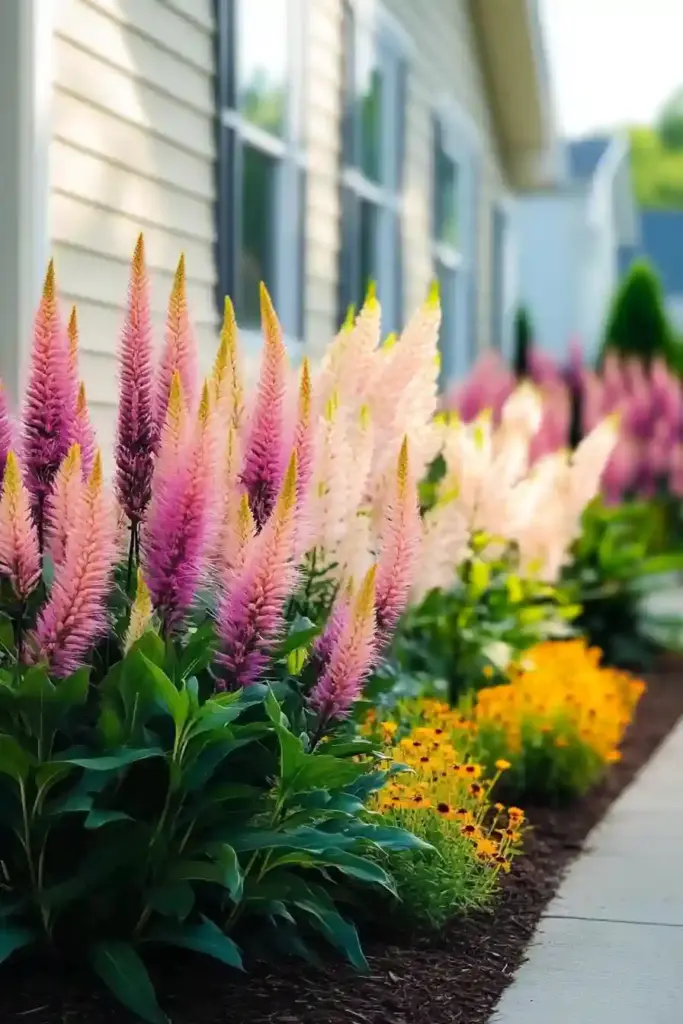
Astilbe is the answer to shady front yards in need of color and elegance. With its feathery plumes in shades of pink, red, white, and lavender, astilbe adds vertical interest and a soft, romantic texture to your garden beds.
Why Choose Astilbe?
- Thrives in partial to full shade
- Blooms mid-to-late summer when many other shade plants are done
- Adds a lush, woodland feel with its fern-like foliage
Growing Tips:
- Prefers consistently moist, well-drained soil
- Add compost or organic mulch to help retain moisture
- Space plants 12–24 inches apart depending on the variety
Design Tip: Use astilbe in clusters beneath trees or alongside hostas and ferns for a rich, layered shade bed. Its fluffy plumes also contrast beautifully with broad-leafed plants.
“Astilbe adds movement and softness to shady spaces—and butterflies love it too!”
🌸 19. Echinacea: Bold Blooms That Thrive on Neglect
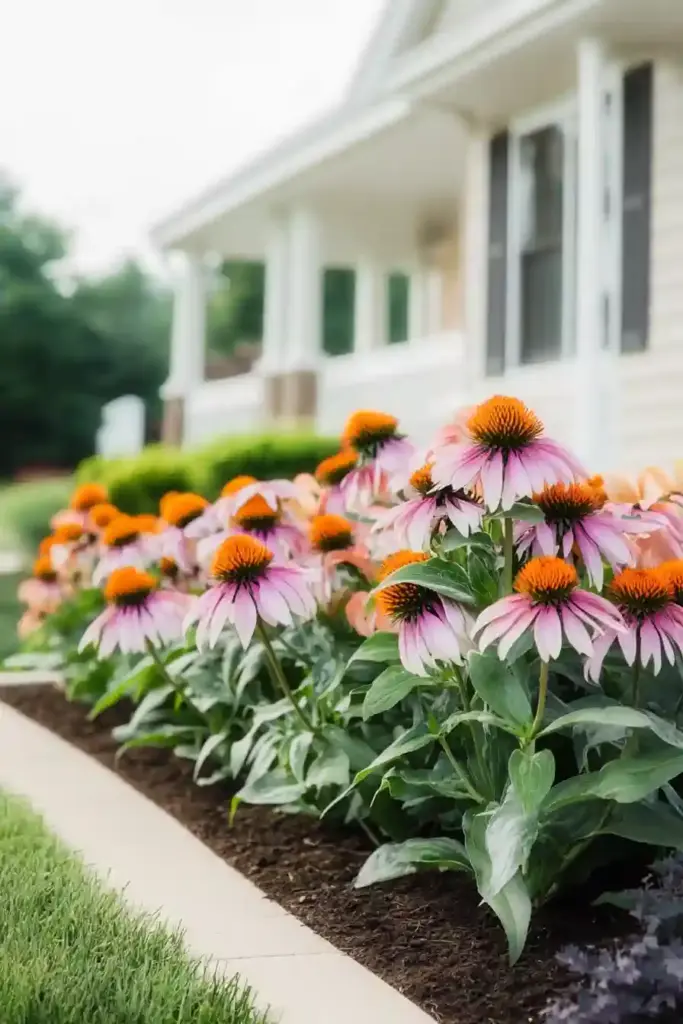
Also known as coneflowers, echinacea is a front yard favorite thanks to its daisy-like blooms, tough-as-nails attitude, and ability to draw in bees and butterflies. These native perennials offer long-lasting color and structure with very little upkeep.
Why Choose Echinacea?
- Blooms from mid-summer to fall
- Comes in classic purples as well as pink, orange, and white varieties
- Drought-resistant and low maintenance
Planting Tips:
- Choose full sun and well-drained soil
- Space 1–3 feet apart for airflow and room to grow
- Deadhead to encourage more blooms, or leave seed heads for winter interest
Design Tip: Mix echinacea with lavender, rudbeckia, or ornamental grasses for a layered, natural look. Their seed heads also add texture and attract birds in fall and winter.
“Echinacea is tough, beautiful, and endlessly giving—just plant it and enjoy the show!”
🌿 20. Snapdragons: Playful Spikes That Add Height and Charm
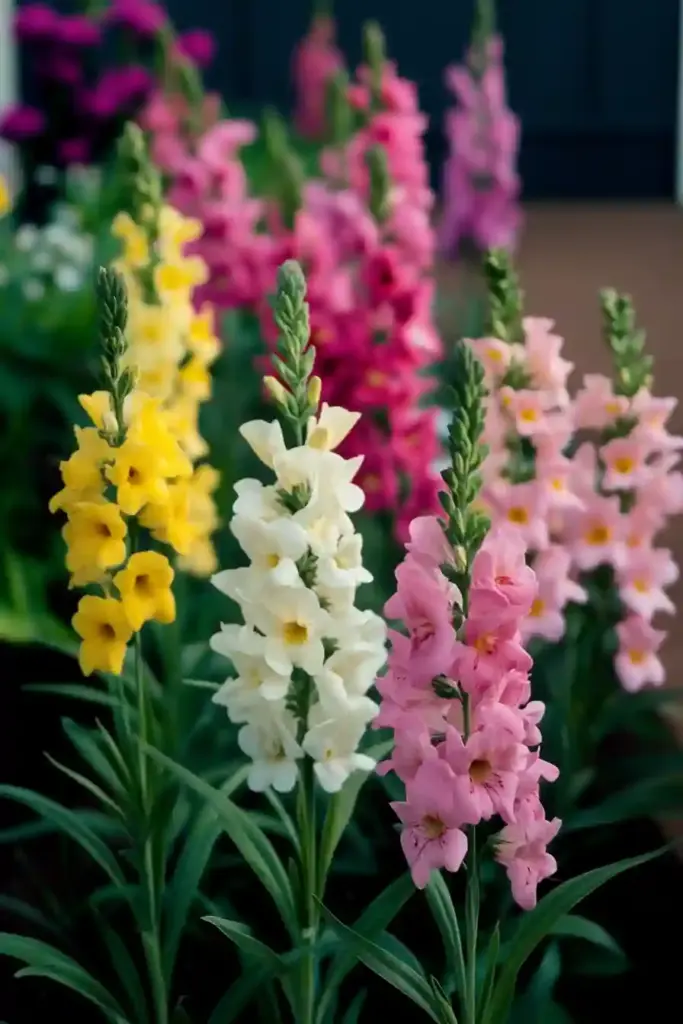
Snapdragons bring vertical interest and playful personality to front yard flower beds. With tall, colorful spikes that bloom in spring and fall, these charming annuals add height, texture, and whimsy to your landscape—plus, kids love “snapping” the blooms!
Why Choose Snapdragons?
- Available in a wide range of colors and sizes (from 6” to 36”)
- Great for early spring and cool-season color
- Attract bees, hummingbirds, and butterflies
Growing Guidelines:
- Thrive in full sun to partial shade
- Prefer cooler temps—best for spring and fall gardens
- Water regularly and fertilize monthly for lush growth
Design Tip: Use snapdragons as a vertical accent in borders or containers. For a charming cottage-style bed, pair them with petunias, alyssum, or pansies at the base.
“Snapdragons add instant structure and seasonal color—plus, they’re just plain fun to grow!”
🌺 21. Impatiens: Vibrant Blooms That Brighten Shady Spaces
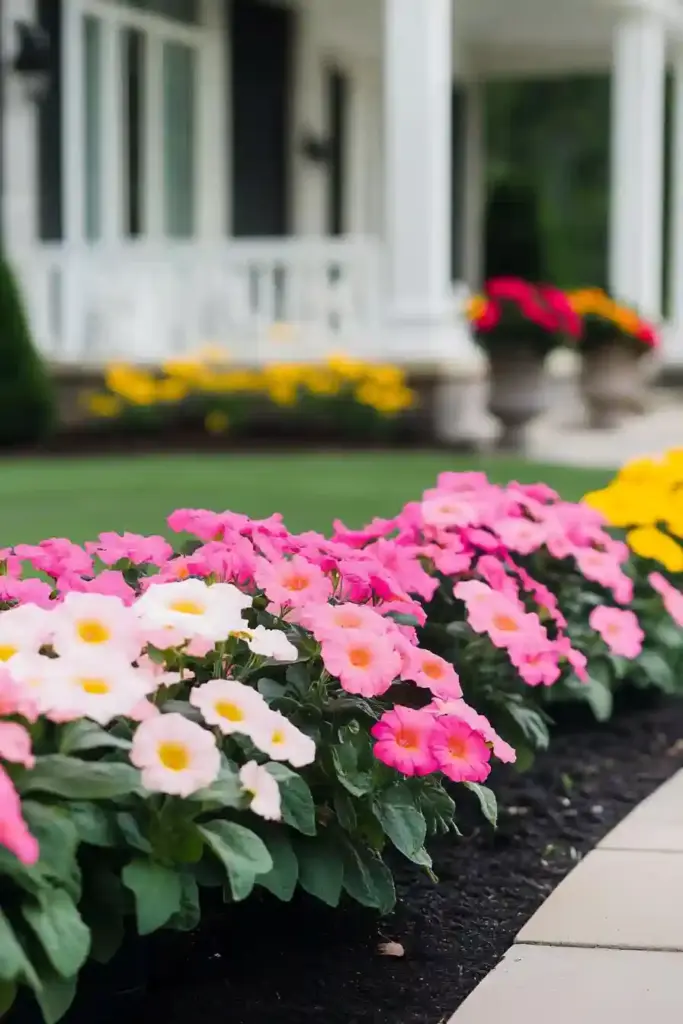
When it comes to low-light areas in your front yard, impatiens are your go-to bloomers. These colorful, compact flowers thrive in the shade and bloom nonstop from spring to frost, turning dim corners into vibrant focal points.
Why Choose Impatiens?
- Excellent for full to partial shade
- Available in red, pink, purple, white, orange, and more
- Ideal for beds, borders, containers, and hanging baskets
Planting Tips:
- Space 6 to 12 inches apart for good airflow
- Keep soil consistently moist, but avoid overwatering
- Apply mulch to help retain moisture and suppress weeds
Design Tip: Mix impatiens in multiple colors for a cheerful, patchwork-style flower bed. They also look amazing under trees, along shady paths, or in porch planters where sun-loving flowers might struggle.
“Impatiens are like a magic trick for shady spots—colorful, easygoing, and endlessly cheerful.”
🌿 Choosing the Right Flowers for Your Front Yard
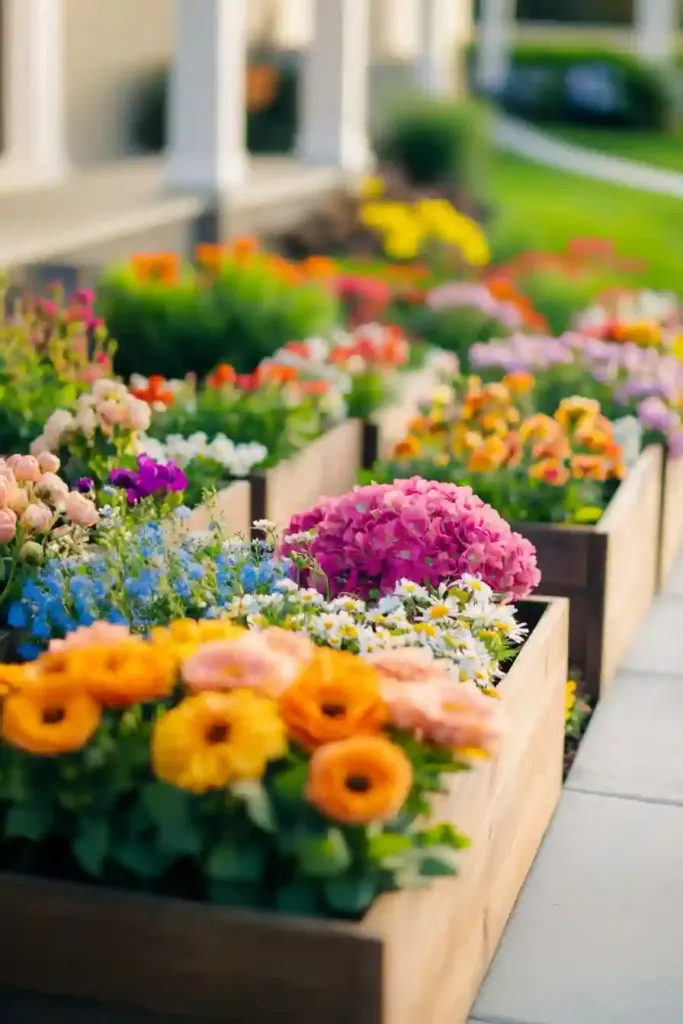
Creating the perfect flower bed starts with choosing plants that match your environment and lifestyle. Here’s how to narrow it down:
🌼 Perennials vs. Annuals
- Perennials (like echinacea, hostas, and peonies) come back year after year—great for low-maintenance gardeners.
- Annuals (like marigolds, petunias, and snapdragons) bloom for a single season but offer intense, vibrant color.
Pro Tip: Mix both! Use perennials for structure and long-term growth, and fill in gaps with annuals for seasonal variety and pops of fresh color.
☀️ Sunlight & Soil Considerations
- Full sun lovers: zinnias, lavender, coreopsis
- Partial shade stars: begonias, impatiens, astilbe
- Test your soil to determine if it’s sandy, clay-heavy, or loamy—then choose plants that thrive in those conditions.
Example: Geraniums and petunias love well-drained soil, while astilbe prefers consistently moist areas.
🎨 Designing Your Flower Beds for Maximum Impact
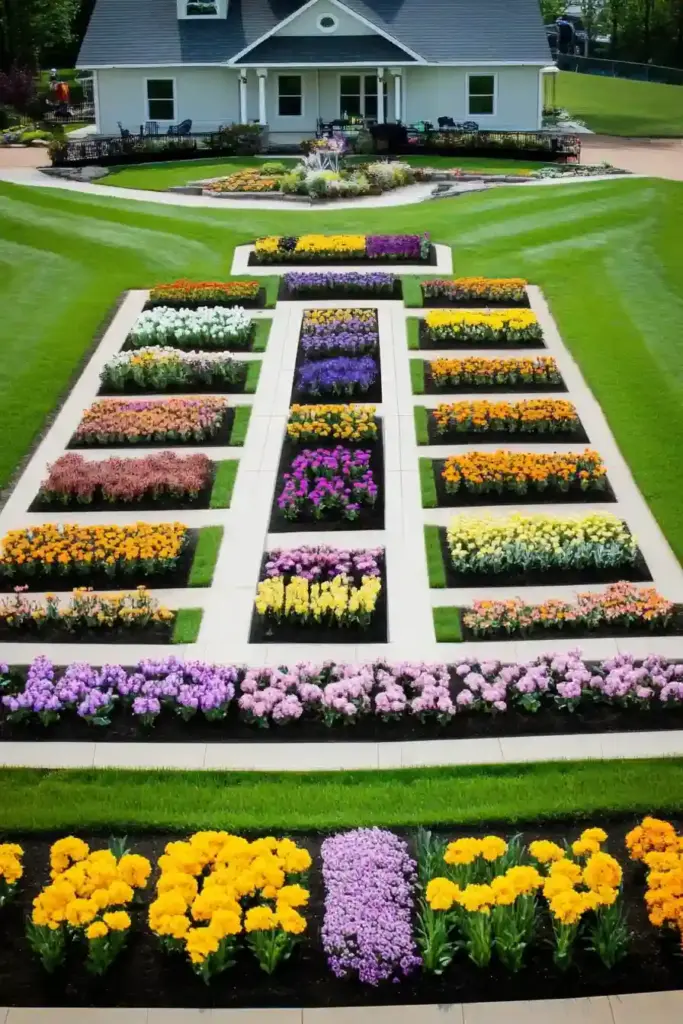
Great flower beds aren’t just about color—they’re about balance, height, and harmony.
🎯 Color Schemes & Themes
- Monochromatic: One color in varying tones for a clean, sophisticated look
- Complementary: Opposite colors (like purple and yellow) for bold contrast
- Analogous: Neighboring colors (like red, orange, and yellow) for a warm, cohesive vibe
🌿 Layering & Plant Height
Create visual flow by staggering plant heights:
- Back row: Tall plants like lilies, snapdragons, or hydrangeas
- Middle: Medium-height flowers like peonies or coreopsis
- Front: Low-growing blooms like petunias, impatiens, or creeping phlox
Don’t forget to fill bare spots with ground covers or mulch for a tidy, professional finish.
✅ Conclusion: Your Front Yard, Transformed
Whether you want a low-maintenance landscape or a show-stopping garden, these flower beds in front of house ideas offer something for every style, space, and skill level. By choosing the right mix of flowers and paying attention to sunlight, soil, and design, you can create a welcoming, colorful entrance that boosts your curb appeal—and your mood—every time you walk outside.
Start small, plant with love, and watch your garden grow into a front-yard masterpiece.

